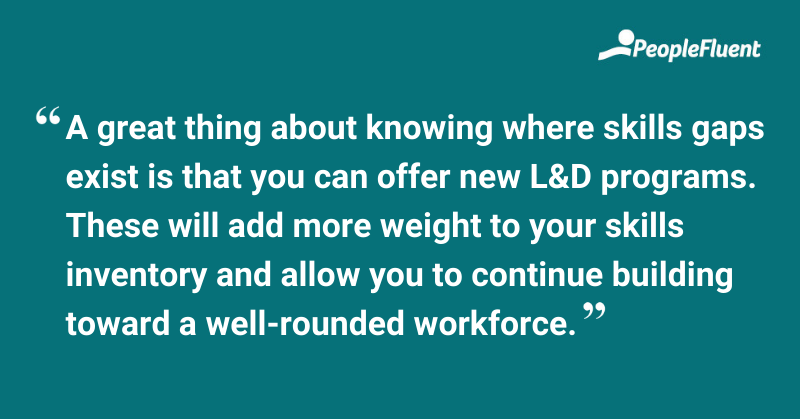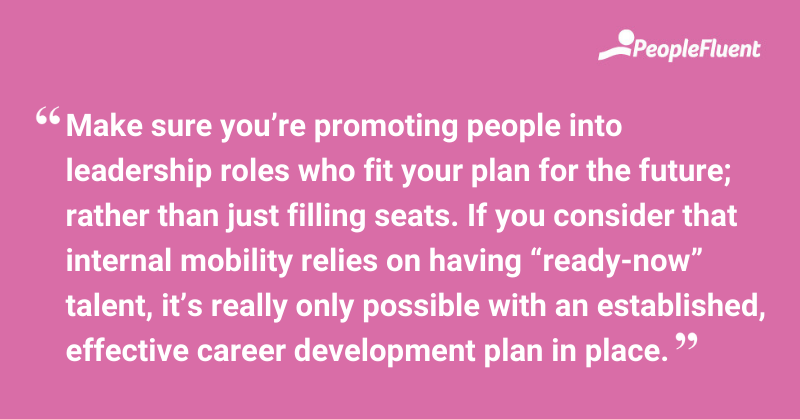Published: Dec 21, 2021Time to read: 6mins Category: Insights
The State of Internal Mobility: 6 Emerging Trends for 2022
Table of Contents
We recently worked with the HR Research Institute to discover the current state of internal mobility. The data offered many insights, specifically about how internal mobility can greatly benefit your organization. In this overview of the full report, we’ll go into detail about the key findings, what they mean for you, and how you can use internal mobility tech to help account for six emerging trends.
Everything from the way we work, live, travel, dine out, and visit friends or family has changed in recent years. We’ve adapted to new ways of celebrating holidays and working with global colleagues across different time zones.
Platforms like Zoom, Google Meet, and their competitors have given leaders better ways for teams to communicate, wherever they are. We’re also now seeing high-performers use tech solutions that are specifically designed to enhance employee development and mobility programs. For instance, a talent mobility platform can help define and reinforce other areas of talent management (like recruitment, performance, and compensation). So what’s next? Onto the trends!
1. You’ll Need to Fine-Tune Your Talent Mobility Practices
Every member of your company will need to understand (and be on board with) your talent mobility practices in the coming year. Start by building programs that account for more visibility, movement, and collaboration. Here are a few practical ways you can do this:
- Provide the tools, resources, and tech needed to roll-out and track internal mobility programs.
- When filling roles, advise recruiters and hiring managers to look at internal candidates first (where it makes sense to do so).
- Give employees information about internal job openings as well as enough time to review and apply to these jobs.
- Test and refine your process until it’s helping you reach your unique talent mobility goals.
2. You Should Consider Skill Mapping (We’ll Explain)
Skill mapping is a formal term for evaluating a person’s current skills. There’s quite a bit of structure to this process, but, the overall goal is to develop a skills inventory of everyone at your company. Having this single place where you can find out what people are good at will help you better identify and overcome skills gaps. As far as how you can find this information, you’ll need a way to gather workforce data and insights so you can start building your inventory.
The great thing about knowing where skills gaps exist is that you can offer new L&D programs to cover them. This will add more weight to your skills inventory and help you build a more well-rounded workforce.

RELATED READING | ‘The Widening Workplace Skills Gap and How to Address It’
3. Lateral Moves Will Be Necessary to Reach Career Goals
On the topic of building skills and allowing people to upskill or reskill themselves, consider lateral moves as a way to keep the ball rolling. First, you’ll need to find out who in the business would be (or is) interested in making such a move. Once you’ve found people who are both fit for purpose and interested in an open role, take action.
For example, John mostly likes being a software engineer—and prefers to stay at this same career level. But, there’s an open role for a technical support position. Taking it would help him learn more about the products he works on, and would help fill an important role. So why not help John reskill himself and reach both of your goals?
4. Succession Management Planning Will Be a High Priority
With internal mobility a driving factor for a lot of workforces, roles are going to be in flux and/or empty for longer periods than normal. More people are coming and going from companies these days, and this creates some challenges for talent acquisition folks. Consider that many of these empty roles include mid- to senior-level positions that are key to reaching business goals and keeping teams running smoothly.
You’ll need a strong succession management plan going forward, so it’s important to start identifying important roles and the people you already have to fill them. This is a critical process, so be sure to set reasonable, attainable goals like:
- Building high-potential candidate pools that are diverse in terms of gender, ethnicity, and other characteristics
- Considering various scenarios to help determine if your plan assures business continuity for those key positions
- Creating opportunities for development and career advancement for people in your high-potential pools
Decide ahead of time who is ultimately responsible for nominating and selecting candidates. You can do this with a succession planning tool that allows for assessments and gathering metrics. Remember that a top-down approach to succession management is only one way you can achieve your goals. You can cast a wider net when you take a bottom-up approach that allows employees to express interest in their long-term career aspirations.

YOU MAY ALSO LIKE | ‘3 Ways Workforce Analytics Can Future-Proof Your Organization’
5. Employee Career Development Will Remain Key
People are more interested in career development than ever before. The 2021 LinkedIn Learning report dove into how important L&D’s role has become over the last two years. The report particularly highlighted employee-driven career development and upskilling/reskilling, and suggested that they should be the top priority across the board. A few ways you can help your staff take control of their development include:
- Offering additional training for managers so they can help employees develop themselves
- Encouraging (and possibly rewarding) managers who focus on helping people with career development
- Determining which metrics your HR teams should use when measuring the success in career development
- Making people aware of the tools and resources they have available to them (in the case of employee-led development)
- Using the information gathered from your career maps to give people insight into what’s needed and which skills they can work on
Regardless of who is leading career development (HR, line managers, or employees), you’ll need to create a strong plan. Build processes that foster collaboration, offer mentorship opportunities, and have candid conversations with people about their future aspirations at your company.
MORE FROM THE BLOG | ‘Team Me Up, Scotty! 4 Ways Talent Mobility Can Create an Out-of-This-World Employee Experience’
6. Internal Mobility Will Inform Other Talent Management Processes
Many of these trends we’ve mentioned draw inspiration from one another. That’s because, at its core, talent mobility is focused on creating connections between internal mobility, succession, and career development. Getting this connection right will require leaders to provide the necessary tech, time, and tools your people need to be successful.
Make sure you’re promoting people into leadership roles who fit your plan for the future. Don’t just fill seats. If you consider that internal mobility relies on having “ready-now” talent, it’s really only possible with an established, effective career development plan in place. Encourage sideways moves and have a skills inventory, as we suggested earlier.This will help your internal mobility programs naturally inform other areas of the talent management process.

Get the full HR.com report here.
Need More Info About How Internal Mobility Can Help Your Business?
To learn more about the effectiveness of internal mobility, succession management, and career development processes—plus the barriers to talent mobility and what actions contribute to success, request a demo or download the product sheet for PeopleFluent Talent Mobility.